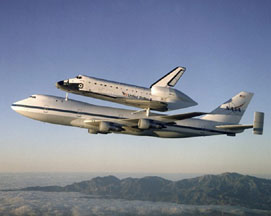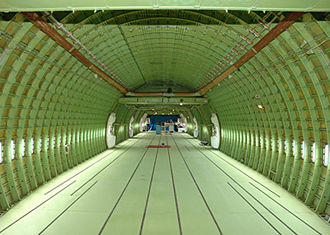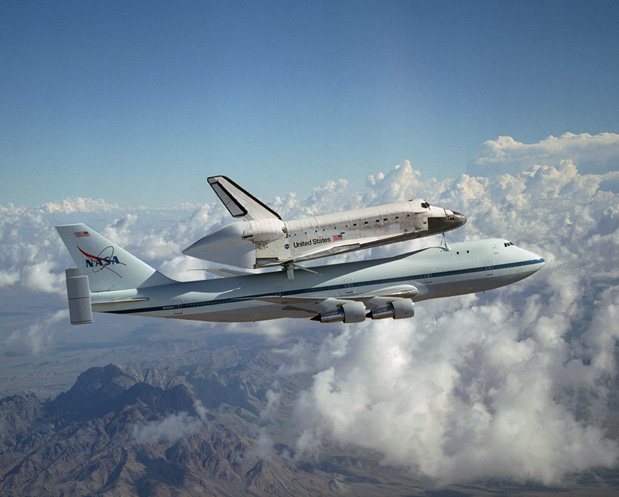
TARGET 060913
The Space Shuttle Goes Home
Watching the Space Shuttle return from space is an amazing sight. The shuttle lands on the runway just like an airplane. However, the shuttle is really more like a glider. Weather can force it to land somewhere other than the Florida landing strip. Getting it back to home base can be a problem. The Shuttle can't take off and fly under its own power. That is where the Shuttle Carrier Aircraft comes into play.
This aircraft is called the piggyback jet. It is used to carry the Space Shuttle back to home base. It has special devices that help keep the Shuttle on the back of the Shuttle Carrier Aircraft. Just like someone carrying you piggyback on his or her back. NASA keeps two 747s, known as the Shuttle Carrier Aircraft (SCA), set up this way on purpose. The downstairs passenger area of these jetliners are kept as hollow inside as possible in order to carry a special cargo: a Space Shuttle orbiter.
In Flight

Ferry flights are few and far between these days, but don't let the light work schedule fool you: These aircraft have to work twice as hard as a normal 747 to get the job done.
"It's brute force that keeps us flying," explains Larry LaRose, a flight engineer on the SCA. "When we're carrying an orbiter, we have to use twice the power and a lot more fuel to maintain flight." These two aircraft together create a lot of weight. The carrier is stripped of its interior and holds a limited amount of fuel to lower the weight. This causes the piggyback jet to make several landings to refuel.
The piggyback also flies at a slower than normal speed. This is another reason for making several landings. The aircraft has to land and refuel every 1,600 kilometers (about 1,000 miles). Because of all these landings, the flight back to Florida takes 1 to 2 days.
Inside the 747

The passenger area has been stripped of many creature comforts, such as galleys, carpeting and even part of the inside temperature ductwork -- all for the sake of reducing weight. But the planes still weigh more than 250,000 pounds, and the drag created by the shape and weight of the orbiter -- 176,000 pounds or more, depending on any onboard payload -- negates the small amount of lift it adds.
Perhaps the biggest challenge the crew faces during a ferry flight is the weather. The orbiter cannot be exposed to moisture, turbulence or temperatures below -9 Centigrade and these restrictions determine the flight path and altitude. To meet those conditions in the winter months, they sometimes fly as low as 10,000 feet.
A "Pathfinder" aircraft, usually a U.S. Air Force cargo plane, flies 100 miles ahead of the SCA carrying weather officers and Space Shuttle personnel from Kennedy. Also onboard is an experienced SCA pilot, whose expertise helps the ferry flight crew keep to the safest route.
The feel of the flight
The piggyback arrangement might look cumbersome, but how does it fly compared to a normal 747?
"It handles remarkably the same," says SCA pilot Gordon Fullerton. As chief pilot at NASA's Dryden Flight Research Center, his daily job involves flying jets for high-performance aircraft research. But Fullerton's experience with the orbiter and SCA dates back nearly three decades. In addition to being a Space Shuttle commander and pilot, he was one of four NASA astronauts to land the Enterprise during the Space Shuttle Approach and Landing Test program in 1977.
"It's obvious [the orbiter] is up there, because there's a constant rumble that you can feel because of the wake of the orbiter hitting the vertical stabilizer of the 747," Fullerton says of ferry flights. But other than long takeoff rolls and the need for some extra care in steep turns, "it's pretty much the same."
However,imagine flying from California to Florida with nowhere to sit, no air conditioning, no place to store your bags -- not even a bathroom.
Landing Piggyback

Space Shuttle Discovery, atop the Shuttle Carrier Aircraft (SCA), touches down at NASA Kennedy Space Center's Shuttle Landing Facility on Aug. 21, 2005 after a ferry flight from Edwards Air Force Base in California. Image credit: NASA/KSC
But how do you get it off?

When the flight arrives, it taxies into place under a special crane. The shuttle is hooked to the crane, unbolted from the plane, and lifted just enough for the plane to back away. The shuttle is then lowered to the ground. In the photo, the crane looks rather small, but just think of it in relation to the size of a 747. Image credit: NASA/KSC
Information for this target was obtained from the following 2 websites:
NASA: "The World's Greatest Piggyback Ride" Click here.
NASA Explores: "Student article" Click here.
